Fukamushi Cha (深蒸し茶), or deep-steamed green tea, is a flavor revelation for green tea fans, and its bolder, sweeter, richer taste can win over those who haven’t yet found a green tea favorite. The very special taste of fukamushi green tea is made possible by steaming the freshly harvested young leaves nearly twice as long as in other green teas, before being rolled dry.
While tea cultivation is found in historical records as far back as the 2nd century BC, the unique methods that produce fukamushi green tea were only developed over the last century. Driven by crises in the international tea trade, and the necessity to make a better drink out of inferior teas, human ingenuity and developing technology came together to make this delicious version of Japanese green tea a reality in post-war Japan. Since then, it has grown in popularity at home, and is finding an increasingly enthusiastic reception worldwide.
So, what makes Fukamushi Green Tea taste so much better than other green teas? Here are five reasons that set it apart, contributing to its unique taste.
1. Deep Steaming Makes the Difference in Color, Mouthfeel, and Flavor
Steaming the leaves for any green tea is necessary to halt fermentation and stop oxidation. In Fukamushi green tea, however, the newly-picked tea leaves are deep steamed, meaning they remain in the steamer for a full minute or even longer, softening the leaves significantly. By contrast, Chumushi (中蒸し normally steamed - aka Futsuu-mushi 普通蒸し) teas are steamed 30 to 40 seconds, and Asamushi (浅蒸し lightly steamed) even less.
The deep steaming process reduces any raw grassy taste or astringency in the finished tea, for a sweeter cup with greater body, robust taste, and smoother mouthfeel. Its aftertaste is also quite mild. While this method was initially developed to remedy the poorer, more astringent taste of lower quality teas, it was quickly discovered that applying this method to superior tea varieties results in an incomparable beverage.
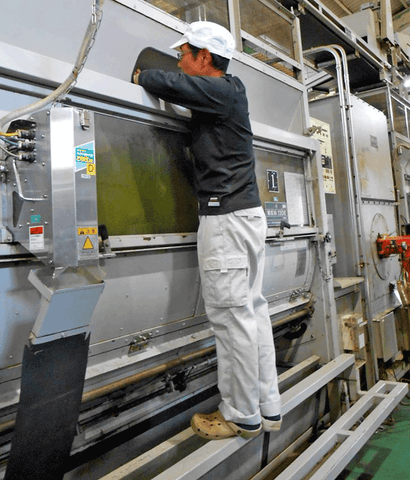 Green Tea Steam Machine at Arahataen Green Tea Processing Facility
Green Tea Steam Machine at Arahataen Green Tea Processing Facility
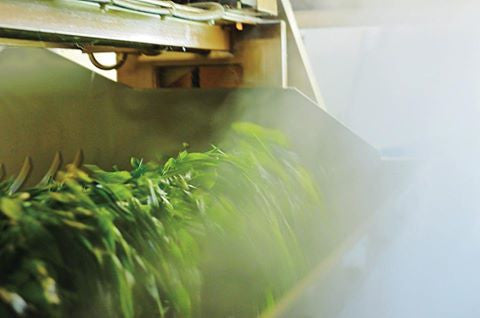
Green Tea Being Steamed
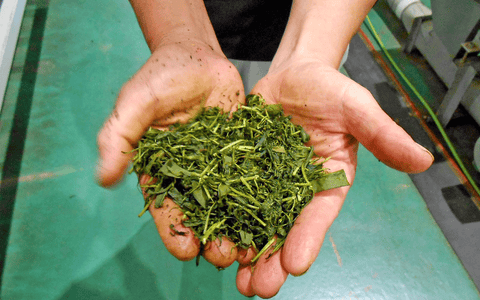
Green Tea Right After Deep Steaming Before Rolling
2.The Roll-drying Method Breaks the Leaves to Release More Flavor
Tea leaves can be dried in many ways, including pan-frying or rolling. In the rolling method, Fukamushi green tea leaves respond differently than the less deeply steamed green teas, being more delicate. Therefore, they break more easily, especially at the delicate tips of the leaves.
Matcha drinkers may especially appreciate that a good portion of Fukamushi leaves break up significantly to form a dust or powder among the whole and broken leaves, providing their cup of tea with a thicker, full-bodied mouthfeel.
On the other hand, those used to Western teas may find Fukamushi's appearance unappealing, and its taste somewhat different than what they expect from green tea. However, the extra nutrients released by the broken leaves make this a taste well worth acquiring.
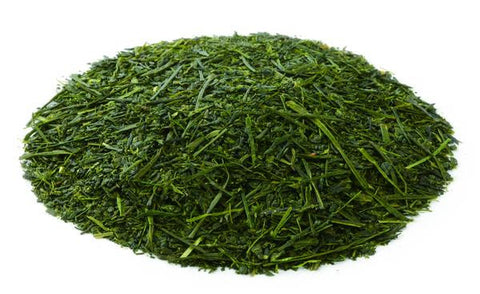
Fukamushi (Deep-Steam) Green Tea After Rolled and Dried
3. Fukamushi’s History of Improving Tea Now Makes Fine Teas Extraordinary
In the mid-20th century, international laws and changes in market opportunities drove Japanese teamakers to develop and improve their deep steaming methods. The deep steaming of Fukamushi proved an effective remedy for the inferior quality of the second harvest of tea leaves. It also worked to remove the astringency and bitterness of any inferior quality teas, or of teas growing in less than ideal conditions such as poorer soil.
When considering such growing conditions, it is worth noting that when tea is grown in flat regions such as Makinohara, Shizuoka, the longer exposure to sunshine results in more nutrients in the leaf. The downside is that the leaf's taste can become harder, but fortunately, this harder taste is offset by Fukamushi's longer steam processing. These teas therefore maximize both health benefits and excellent flavor.
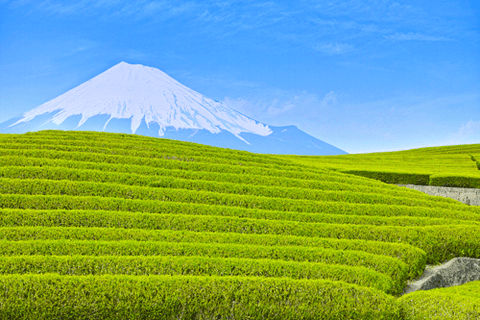
Makinohara Tea Farm, Shizuoka - flat region having longer exposure to sunshine
The stronger, sweeter taste and bolder mouthfeel could even overcome the deficiencies in 20th century urban tap water, and so Fukamushi green tea quickly increased in popularity. This fueled further improvements in steaming and drying methods, as well as the development of specialized teapots that are better suited to cope with the finer texture of the leaves.
With this growing popularity, attention switched from repairing poor teas, to enhancing even the finest tea varieties with the deep steaming method. The result is a rich, delicious, extraordinary cup of tea.
4. Faster Brewing Times Lead to Less Bitterness
Brewing a pot of Fukamushi green tea is much like other green teas, but with a few essential differences. To begin with, you’ll need a fine mesh strainer if your pot doesn’t have one already, due to the nature of the fragile deep-steamed leaves.
The picture shown is 12Oz Fukamushi Tea Pot. This type of tea pot is specifically meant to brew Fukamushi tea having finer mesh.

Fukamushi Tea Pot - Specialized for Fukamushi Tea
The second essential difference is that Fukamushi green tea only needs to steep 40 seconds before it is ready to pour. This is about half as long as the typical steeping times of one to two minutes for more lightly steamed teas. Steeping too long, or at too high a temperature, are common causes of bitterness in brewed tea, but fortunately, the brief preparation time for Fukamushi green tea ensures a sweet and delicious result, with a light, delicate aroma. See below section for more information about making a perfect cup of Fukamushi green tea.
5. Fukamushi Methods Enhance an Extensive Variety of Excellent Teas
As Fukamushi tea has grown in popularity in Japan and abroad, the teas selected for this process are among the finest available, grown in ideal conditions such as those in Shizuoka or Kagoshima.
Deep steaming is simply a processing method after all, not a type or variety of tea. So, you can explore different manufacturers and providers to discover your perfect flavor, find just the right blend, or explore the choices from your favorite tea-growing region. Whatever leaf you choose will be made even better by the deep-steaming process.
What Can I Expect In My First Cup of Fukamushi Green Tea?
Bolder flavor comes with bolder color, and you’ll likely find that your Fukamushi tea is a richer, more vibrant green than other teas you’ve enjoyed. Because of the delicate deep steamed leaves, the bottom of your cup will likely hold some sediment, adding to the depth of color and robust flavor.
The aroma, however, will be more delicate, and not as strong as other green teas.
 Fukamushi tea is a richer, more vibrant green than other teas
Fukamushi tea is a richer, more vibrant green than other teas
Making a Perfect Cup of Fukamushi Green Tea

Brewing a pot of Fukamushi green tea is much like other green teas, but you’ll need a fine mesh strainer if your pot doesn’t have one already.
You’ll notice that the tea leaves look different than other green teas you may be used to. The deep steaming process leaves them softer and more delicate, so that when they go through the rolling process, they break into pieces and may even include a matcha-like powder mixed in.
Many tea experts recommend using neither fresh tap water nor distilled water, as the taste of your tea will suffer from the added chemicals or the complete lack of minerals. Boil spring water instead if you can, or carbon-filtered tap water at the very least. When ready, pour the boiling water into the cups you will serve.
Add one scant teaspoon of tea leaves per cup into your teapot. Next, empty the teacups of hot water into the teapot over the tea leaves. The water will now be slightly cooled from boiling, or approximately 150-170 degrees Fahrenheit.
Place the lid on your teapot and wait no longer than 40 seconds. Now, pour your tea by adding only a tiny bit at a time to each cup in turn, repeating until each cup is full, so that each cup will end up with a similar consistency of tea as the rest. Enjoy!
Ancient Flavor, Modern Innovation
From the Zen temples of Kyoto, to Tokyo’s cutting-edge industries, Japan is known worldwide for its ability to embrace the best of the old and new together. Fukamushi green tea is a delicious and beautiful example of this innovative spirit, using modern technologies to enhance the world’s most beloved and ancient beverage. With all the health benefits of green tea, and a full-bodied flavor, it’s no wonder Fukamushi green tea is becoming a worldwide favorite.
If you’re ready to try this delicious Japanese green tea, be sure to pick up a teapot equipped for the finer leaf particles. Shopping around will help you discover beautiful and traditional Fukamushi teapots to celebrate your first cup of this extraordinary green tea.
Buy Fukamushi Green Tea Now
Get Free Bonus Books

Sign up for free to the Green Tea Club to get advice and exclusive articles about how to choose Japanese Tea, and tips, tricks, and recipes for enjoying Japanese tea.
About the author
Kei Nishida
Author, CEO Dream of Japan
Certification: PMP, BS in Computer Science
Education: Western Washington University
Kei Nishida is a Japanese green tea enthusiast, a writer, and the founder and CEO of Japanese Green Tea Co., a Dream of Japan Company. His passion for introducing America to the tea of his homeland was the catalyst for creating the only company that brings high-quality tea from Arahataen Green Tea Farms to the rest of the world. Learn more about Kei






















